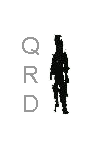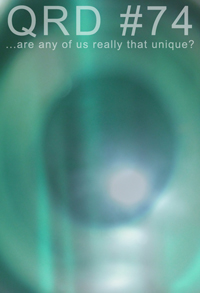
 |
| about
this issue Featured Band Interview: Rivulets Bass Player Interviews: Tony Zanella of +/- Channing Azure of Alpha Cop Eric Baldoni of Colt Vista Jeanne Kennedy Crosby Rob Kohler Derek M. Poteat Guitarist interviews: Campbell Kneale Antony Milton of PseudoArcana Nevada Hill of Bludded Head Malcolm Brickhouse Chvad SB Scott Endres of Make Label Owner Interviews: Russian Winter Records Hello.L.A. Moving Furniture Basses Frequences Saxwand Records Comic Creator Interviews: Richard Van Ingram Tyler Sowles JB Sapienza Troy Vevasis Victor Couwenbergh Terry Hooper Travis Hymel Robert Hendricks Dirk Manning |
 |
 |
 |
 |
 |
 |
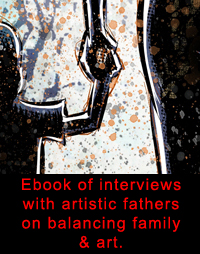 |
|
|
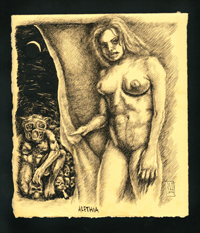 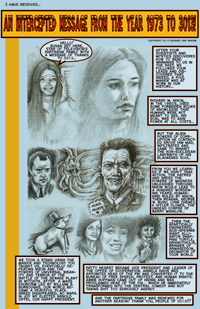 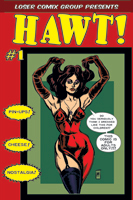 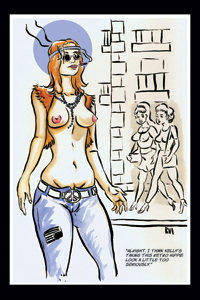 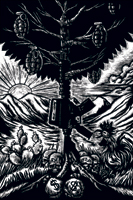 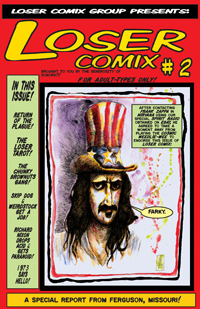 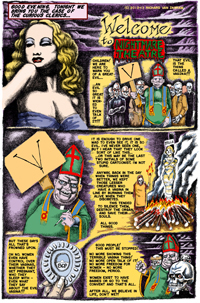 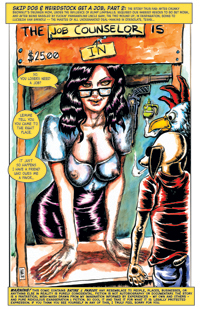 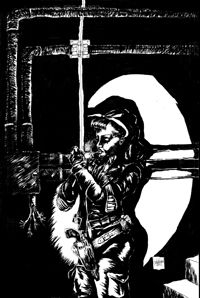 |
July 2015
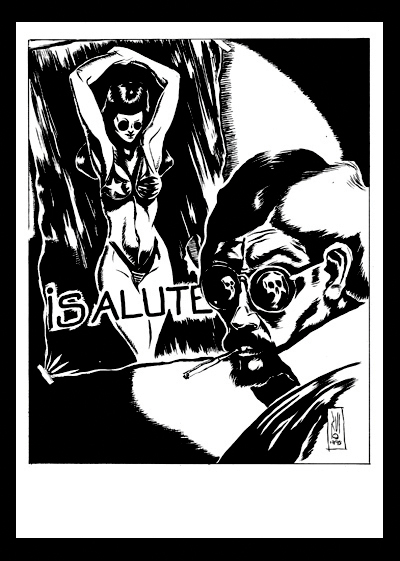
Name: Richard Van Ingram
City: San Antonio, TX
Comix: Loser Comix; Hawt!; Addison & Steele; “Return of the Plague”; "It Ate the Future”; “Chunky Brownuts”; “Welcome to Nightmare Theatre”; “Tales of Rural Depravity”; “The Loser Tarot”; etc.
Websites: www.losercomix.com, www.richardvaningram.com
QRD – How old were you when you first got into comics & did you always stick with them or did you come back to them?
Richard – If you include comic strips in the papers, there is no time in my life I can’t recall being fascinated by comics -- from the “funny pages” to the editorial comics (Herblock was the first editorial cartoonist I recall seeing). Charles Schulz’s Peanuts was the strip I always loved -- still do. Before I could read, I thought the strip was entirely about the dog. So to put an arbitrary time on it, that would be at least at the age of two, maybe less... about 1967, ‘68.
I saw comic books in the drug store regularly by the late ‘60s, but my parents were under the delusion they were terrible things. But by ‘69, I had begged & wheedled my mother to the point she bought me a horror comic -- a Charleston title of some sort, I think... not very good, I’m sure, but I was hooked. The images, the words, the feel of the paper, the lurid covers, the very smell of the ink on newsprint. That smell still sets my heart a-pounding.
All through the ‘70s I bought Marvel comics of all sorts, magazines, & MAD. No DC. Nothing, nada. DC books struck me as literally two-dimensional & implausible, childish. Marvel -- well, Marvel had characters that had a psychology, weaknesses beyond something idiotic like Kryptonite, conflicts of interest. When Jack Kirby came back to Marvel, I bought everything he did -- he was my favorite -- & then I went back & bought his DC books -- especially New Gods, Kamandi, & The Demon. The Demon was my favorite -- talk about personality issues & psychological problems!
Horror was my favorite... the stranger the better. Gave me terrible nightmares, but I’d go right back the next day. The Warren black & white mags were great for that. I went without lunch & picked up Coke bottles -- you could get a nickel, then a dime for a Coke bottle back then. After school, I’d scour the whole town’s ditches for those things & then go turn them in &, little by little, hit every comic & mag rack within walking distance.
In my own time, I’d draw & write my own stories -- almost always my own characters. I think the only thing with someone else’s characters I ever drew alone was the original ‘70s Star Wars line-up (& that mutated into a satire). Because of my father’s religion, I couldn’t go to movies, but I bought the novel, movie magazines, anything science fiction or horror related &, along the way, I accidentally discovered Underground Comix. At age 10, I checked out Les Daniel’s history of the comix from the local college library & my creative mind was rearranged forever. That & Mad Magazine reprinted the first few issues of the Kurtzman Mad -- I fell in love with Will Elder & Wally Wood there. My growing interest in the female form led to looking at girlie magazines (pays to have older friends) & I found Kurtzman & Elder’s Little Annie Fanny. Among other things.
Long, long story short, I was a die hard comic & comix reader til after high school when, in 1984, I entered college & found the habit was not conducive to being taken seriously by art professors, english professors, or women. So I put away the things, concentrated on becoming a “serious” artist & writer & man of the world.
Picked them back up when someone handed me Watchmen around 1990 & forced me to read it. Mind blown a second time -- that comix could be literature & genuine art... the things were a medium capable of... anything; they are not a formula or simply genre literature. So back to reading the alternative titles & collecting old undergrounds & working on my own ideas.
QRD – How old were you when you put out your first comic?
Richard – My childhood friend, Matthew Thompson & I made a Super Chicken-inspired comic book together in 2nd or 3rd grade -- we collaborated closely, I did most of the drawing & helped work out the plots, but Matthew’s sense of humor verbally was sharper than mine, so he wrote dialogue. We’d pass these things around. Who knows what happened to them? Or Matthew, for that matter -- he moved.
QRD – What decade do you think produced the best comics?
Richard – The best decade? Hard to say. I’m stuck between the ‘40s & the ‘60s -- the ‘40s because of Will Eisner, Jack Kirby, & wicked crime comics (which I adore) created the groundwork for anything good in comics & the 1960s because the undergrounders broke every limit & taboo & made comics safe for adults, mature themes, & genuine political satire & discourse -- Spain Rodriguez, Gilbert Shelton, Jaxxon, & the women’s movement in comix opened the way for people like me. Crumb gets all the attention because he’s one hell of a draughtsman, but S. Clay Wilson, for example, was a thousand times more transgressive... enough nihilism to scare the bejeezus out of anyone.
QRD – Why comics instead of just writing or drawing?
Richard – Why comics? Comics, as a medium, can present, in a coherent manner, multiple perspectives all at once, multiple approaches, styles, symbolic content, depths of meaning, leading & misleading verbal messages & poetry.... The closest novelistic approaches I can think of to what comics, as a medium, are capable of, would be John Dos Passos’ USA Trilogy or much of William S. Burroughs’s works, like Cities of the Red Night.
But with comics, I can have a direction or themes & ideas similar to, say, Dos Passos or Burroughs & weave in layers of meaning through the imagery, the symbols, the juxtaposition of word & image -- & whether they are consistent with one another. (e.g. Make a play on what is real & what is surface, or a lie, or what is projected: Think about the short section of images in Watchmen where Ozymandias is explaining himself & his motives versus the images that are completely opposed to everything he’s saying. Is he lying outright? Is he delusional? Both? How self-conscious is he of what he’s doing & why? & just what is the real joke here & who has it been played upon?)
You’ll never get that out of just writing -- writing is superior at certain things; but has no visual element, just description & implication; hell, you can’t approach that in cinema without confusing the audience -- although, because of the possibility of a soundtrack, it also surreptitiously manipulates emotion; & pure pictorial art or sculpture, whatever, is better at concentrating meaning or symbolism in an ambiguous fashion within a limited space & time leading to a lasting memory of its material “punch” or effectiveness.
Comics -- we can savor, go back over, read backwards, re-visit passages, & the visual aspect lays hold of memory & only shifts as interpretation shifts.
QRD – Do you see mini-comics & indie comics as paths to mainstream comics or as their own unique media?
Richard – Mini-Comics & indies are ends in themselves. One supposes they could be used to break into the “mainstream”, but I’m unsure why anyone with as much control & freedom as someone making minis & indies would want to be chained down by a mainstream publisher & its financial demands to manufacture “product”. Preferably “product” that can be further monetized by licensing & movie rights.
However, if that’s your thing, why not? Believe me, I do understand why an artist/writer would want to make a living at what she does & a good living -- it’s unfortunate that the big publishers & their distribution system have monopolized things to the point independents can’t also eke out a meager financial life pursuing their own visions, too. Such, however, is our present state of affairs under free market capitalism & bubble market speculation by media giants.
QRD – How many copies of your comic do you print in your first run?
Richard – On the first run of my first book of the 2000s, I made 30. It was a rush job for a con & I wound up giving 28 out of 30 away for free as advertizing (I kept two). Other books I’ve kept sitting back at print-on-demand sites til I’m ready to shove out a real edition with my own printer; but with Loser Comix #2, I printed up a few over 1000 mainly to take to conventions. & sell, not give away.
I also make these little fake Jack T. Chick-inspired tracts that are not about religion, but about challenging people to be creative & politically active. Preferably liberal & politically active. Worked for that son of a bitch Chick & the Chinese Communist propagandists (& Tijuana Bibles, for that matter), so why not for a better form of propaganda as well? I churn out as many of those as I can stand to chop & staple. Maybe I’ll make one for kids -- just something fun as they really can’t look at any of my other work at a con table, which is for adults. Maybe... if I can resist having an Old One emerging from transdimensional space to senselessly consume Bambi in the last panel.
QRD – How much do you think comics should cost?
Richard – Comics should cost enough for the creator to walk away with a fair profit for the labor. After printing costs & the price of a con booth, though... unless you’re a mass producer, corporate comics company, that may be about impossible -- getting away with enough cash to print your next book might have to be the goal. Right now, I’m satisfied with that. Satisfied, not thrilled.
QRD – How many books do you produce a year & how many would you like to?
Richard – I’m lucky to get out 1 - 2 42-ish page books a year. I could do more if I cut the page number, obviously, but I like to give good value for the money & try to have a couple of extended stories an issue (that’s with Loser Comix), stand-alone, & connected sometimes. I’d prefer to publish quarterly & if the revenue came in more often, I would. I’m always working on material & setting it back for use later. Often, it will be a couple of years between when I make something & when it shows up in print in finished form.
QRD – Do you think stories should be serialized or delivered as complete works?
Richard – Obviously, for me, I like both serialized & stand-alone stories, as I said. If a whole book is committed to one story, I’ll make it a stand-alone. Otherwise, if I serialize something in a book with other stories, I’ll eventually collect it all in one book, but that may take... who knows how long. As for others, when the books are coming out regularly, I don’t mind serialized stories in each issue with multiple story arcs. That’s rather nice, really.
QRD – How are comic strips different than comic books & which medium do you prefer?
Richard – Strips are punchy & short; you have to condense something to between one & four panels, usually. They lend themselves to humor where you, indeed, get a punch line at the end or some manner of absurdity. I like them, but they are difficult to make if you are not exactly succinct (like me) -- they are the Twitter of the comics medium. Comics lend themselves to character development & experimentation with imagery & symbolism. Plus one can afford to be a bit expansive with dialogue or narration here & there, though “too much” is deadly. People like Charles Burns & Daniel Clowes have this down to a genuine art form: Never too much or too little. Me -- I’m working at it.
QRD – How long is it from when you start a comic until it’s printed?
Richard – As I said, it could be years between when something is completed & when it winds up in a book. However, I have slammed out a full book in as little as two weeks between writing, planning, creating, & firing the whole thing off to the printer. Depends on money & how much missionary zeal I have for the project.
QRD – What do you do better with your comics now than when you first started?
Richard – Easily, the thing I do better now than when I began, if we just count my adult years here, is that I am a much better inker. I often even skip most of the penciling & just draw/paint in ink. I think in black & white by second nature -- one of my degrees is in printmaking, so it just comes easily. & when I just plan the work out in my head & then work directly with the ink, the look is fresher, more expressive, less stilted somehow.
QRD – Do you do thumbnails?
Richard – I rarely do thumbnails. I used to do meticulous thumbnails & studies, but, again, I find it kills the “freshness” of more spontaneous looking work. If I do “thumbnails” now, they’re with a black sharpie marker on a huge newsprint pad where I block out the shadows & dialogue placement -- really rough & fast until I’m happy enough. Then I don’t look at it again. I let some time pass & use my memory & re-interpret the whole thing so I don’t feel “locked in”; making a comic book isn’t like copying a coloring book. Not for me. I’d rather wind up with a quirky look in the end than a cold, perfect, meticulous look. Again, that fits my stories better.
This is not to say I don’t use photo references -- but not slavishly. They’re a starting point, not an end point.
QRD – At what size do you draw?
Richard – Size -- 11 X 17. The size of my scanner. Though I’ve been tempted to draw larger, then chop the panels down in Photoshop, size them, & paste them on a virtual 11X17 sheet -- my eyes are very weak & I prefer working large anyway.
QRD – What kind of pens do you use?
Richard – When I use pens, I use steel mapping pens, crowquills, Microns (usually .005). I love technical pens, but the heat & humidity of San Antonio murder them, which makes their use cost prohibitive. I’ve had them last months; I’ve had new ones die in 15 minutes. Better just to stick with the old fashioned stuff. Mostly, I use brushes, Windsor & Newton Series 7 watercolor brushes, round, anything from #0 to #5 (I prefer the small sizes -- #2 is already pretty large). Treat them right, they last forever.
I’ll black in large areas with big, flat watercolor brushes & cheap pens. I also like Japanese cartridge ink brushes -- but you can’t watercolor over them. On the other hand, they’re mobile & tough, the ink lasts a good while. I will also use black Prismacolor pencils for shading or just drawing -- they reproduce very well -- & use a toothy paper, like colored charcoal papers. You can put in highlights with Prismacolor white pencils or use the paint tool on white at high transparency in Photoshop; or both.
QRD – What does your workstation look like?
Richard – My workstation -- heh. I have a studio. It looks like a bomb got tossed in here. I function best in chaos. I’ll straighten it all up, put away everything, then, when I work, spend two hours hunting for everything I use. May as well leave it at hand. No one comes in here but me, so there. Deal with it. I’m a cross between Oscar the Grouch & Oscar Madison (the old one, from TV, Jack Klugman). How I wound up not named Oscar is a miracle.
QRD – At what point in the artistic process do you work digitally?
Richard – After I ink -- & sometimes I color with watercolor -- I scan & digitize the work, punch up the colors or darken the blacks, work in CMYK to make adjustments, & then letter in Illustrator if I didn’t scrawl it by hand. I have a nice collection of fonts to use & some of them are much better than my hand lettering or they give that special look -- like the Kroy-esque letters that were made by scanning old EC comic lettering, warts & all. Instant antiquity & creepiness.
QRD – What do you think of digital comics & webcomics?
Richard – Digital comics & webcomics are an excellent way to break into the field & begin getting a fan base. They are a terrible way to make a living. No matter how much you charge for a digital comic, it can easily be pirated -- & will. We are now dealing with a generation of people who want to be entertained... for free. No understanding of the effort & materials & experience required to make even simple work. & it is work. If one wishes to give away one’s labor -- I do, at times -- just understand that one of the by-products is the audience gets used to obtaining your comics & every one else’s for free.
Once upon a time, inside my lifetime (I’m pushing 50, kids), it was possible to make some money by being a cartoonist & writer. Up through the 1990s, you could illustrate & write for tabletop RPGs; there were many, many publications who’d at least pay something for labor & comic books or a strip. Most people understood that, if you want creative work, you had to at least pay something up front.... not offer to pay out of imagined profits that mysteriously never arrive. By the time I returned to comics in 2009, the business model had changed entirely: Make things to give away for free on the net & speculate you might make actual cash at cons or your website by selling merchandise & ad space. For most of us, no matter how skilled you are, no matter the quality, you get no meaningful financial compensation at any point in that process -- that’s the reality. Some manage to network & pull it off -- more power to them. Most of us don’t.
If I have a major problem with solely digitizing comics or webcomics: It leaves no physical book to collect or savor. The reading experience, the tactile experience, the kinetic experience of seeing printed work & interacting with it is entirely different than trying to see a book online or on a postage stamp-sized phone screen.
I could go on & on about this -- I have elsewhere. In the end, I think I’m a remnant of a dying age of literacy & art appreciation. I’m inclined to think my side will lose this argument -- it already is -- &, assuming comics survive as a medium, future generations will lose the traditions, the history, & experiences attached to possessing, sharing, & enjoying an actual comic book. Nothing to pass along to your kids, either. Such is fortune.
QRD – Do you prefer working in color or black & white?
Richard – My preference is black & white work -- it’s moody. By inclination, almost everything I do turns out noir-ish & expressionistic, tied to the horror tradition even when I mix in political themes or a little philosophy & a lot of satire & parody. Which is OK. However, I’ve found most people like color work better than even the best B&W art... so most of my things involve coloring, either by hand (which I enjoy) or more usually in Photoshop (though I tend to use a very limited palette on purpose). The ink remains THE thing with me & I don’t attempt to dazzle or distract from poor draftsmanship by slapping on over-saturated color. Again, my background as a printmaker first & a serious watercolorist second come into play.
QRD – How many different people should work on a comic & what should their jobs be?
Richard – As many people should collaborate on a book as necessary, given the group & the need for speed. I work alone. I’ve collaborated in the (distant) past & was good at interpreting a script into effective imagery & I like to talk with others & pay attention to what they do & their techniques -- but, these days, in the end, I’m doing my own stuff the way I think it needs to be done. Since it’s usually a labor of love, why not?
QRD – How do you find collaborators?
Richard – More on collaborators: I don’t look for any, but get asked from time to time to do other’s books or stories. For free. If I’m going to work for nothing up front, I’m doing my own things -- I just don’t have time anymore to do anything else (I lecture in philosophy & ethics for a living -- time consuming). I have been asked to be part of anthology books twice in the past couple of years & twice the projects wound up transmogrifying & being taken over by other people who decided to cut me out of the final book -- because we were not “buddies”. I’m not opposed to anthologies, per se, but I’m getting everything in writing from now on so no one winds up jerking my chain -- on purpose or inadvertently. “Get it in writing!” should be the words hanging in every indie or underground studio.
QRD – How tight do you think a script should be as far as telling the artist what to draw?
Richard – My scripts -- the ones I write for myself -- have ranged between utterly tight to non-existent. Usually, I have an idea that I flesh out as I draw/ink & I let the characters “tell” me what they’d do & say inside the limitations of the story. Sometimes, the story goes off in an unexpected direction & I just revise what I’m doing. That’s actually a very fun way to work -- a greater challenge to make something coherent & meaningful that way. If I screw it up, I set aside the pages that don’t work & just start again -- it’s not as if anyone will know til after I’m done. Sometimes I get my wife, who knows literature & doesn’t look at comics, to read a completed piece just to get her perspective: “Can you tell me what’s going on here? Does it make sense?” If it passes that test, I’m in the clear. If not, back to the drawing board... sometimes.
QRD – Do you think it's important to have a full story arc completely written before starting to draw?
Richard – For me, no. I don’t always need a story arc other than the vague idea of where things are going I carry in my memory. Sometimes, I’ll work it out on paper, but reserve the right to amend or dispose of it if something more attractive comes along. If I made works that were much longer or more complex -- &, given time, I will -- I’d have to lay it all out in detail ahead of time. But right now, not so much.
QRD – What comic book person would you be most flattered to be compared to?
Richard – The comic book person I’d be most flattered to be compared to? Two names come to mind -- Will Eisner & Spain Rodriguez. In the end, though, I think it’d be Spain.
QRD – What do your friends & family think of your comics?
Richard – What do my friends & family think of my comics? Well, a great number of friends, whether they even like my work or not, contributed a tremendous amount of money to my getting LOSER COMIX#2 printed. Many of them enjoy my art -- others like my message. Some are just generous & decent. My wife likes my work & is my greatest supporter. My son enjoys my books (he’s 21), but is frightened to show them around (which is funny). My step-daughter (23) probably thinks I’m terrible, but likes some of my art. My step-son (25) has never said anything one way or another. I don’t think he’s interested. My mother hasn’t ever seen any of my work & she’d probably disapprove. If my father were able (he’s in a nursing home), he might accept a copy & then never open it & put it in a drawer somewhere & lose it.
QRD – What do you think of superheroes?
Richard – After Watchmen & the Rick Veitch’s works put the coffin nails in the very notion of adults taking superheroes seriously, I gave up on them except as satire. Superheroes are cool for young people -- I learned a very rudimentary sort of ethical code through Jack Kirby’s stories; I owe that man for not turning out to be an utterly criminal juvenile delinquent. Superheroes are ideals, images of perfection to look up to for kids -- “New Gods” indeed!
But as an adult, after too much experience of how un-ideal life is, how vicious people can be, what human goodness actually looks like in practice (it cannot be “ideal”or perfect), the corruption & destruction of so many institutions & politicians -- as well as the good present in many of them; after realizing the complexities & ambiguities of human existence & history... how can I read anything for children except when I’m nostalgic? Much less make the stuff. I’m not optimistic like Kirby -- I come from a different time, a different generation (Gen X). Nor am I inclined to make superheroes that are psychopathic violence machines -- kids don’t need that & I have some concern for adults who are solely addicted to that sort of thing. I am a neo-Stoic, a bit of a manic- depressive pessimist, or at least a stupidly hopeful fatalist, a sort of existentialist in the tradition of Jose Ortega y Gasset & Albert Camus & have complex religious views that I force on no one. My calling isn’t to make comics for kids... I speak to adults with all our hopes, despair, wounds, & bitter, black humor. With added fun & pictures.
QRD – Marvel or DC?
Richard – Marvel or DC?!!!! East Village Other or Rip Off Press.
QRD – What comic characters other than your own would you like to work with?
Richard – Other comic characters I’d like to work with: I find Rush Limbaugh to be a good comic character to work with; he becomes “Rump Limpballs” in my “Chunky Brownuts” stories. & the Chunky Brownuts characters in no way whatsoever resemble Schultz’s Peanuts characters. At all. Swear.
QRD – Ideally would you self-publish?
Richard – I do self-publish. I’m livin’ the vita loca dream, man!
QRD – What conventions do you try to attend & why?
Richard – I attend any conventions I can drive to & have cash to buy a booth. I’ll be at Texas Comicon, August 7-9 this year in artist’s alley. Come on down to San Antone & say “Howdy!” I’d fly out to larger cons if I had money, but presently I’m broke as a convict.
QRD – How do you feel about doing work for anthologies?
Richard – I think I spoke earlier about my experience with anthologies -- like the idea, but need a contract to participate.
QRD – What do you do to promote your books?
Richard – Promotion -- I have my websites, I have a Facebook page for Loser Comix Group, I beg people. I hit conventions to sell & meet people. I beg. Eventually, I’ll start driving around to various places like comic shops, tattoo parlors, “smoke” shops & beg them to sell at a major discount. Next go ‘round, I’ll be in Fogel’s Underground Price Guide & maybe also buy some ad space. I do interviews, I was featured in The Blotter a while back & The Blotter runs ads for me sometimes -- big supporters. & I also beg.
QRD – Do you think your comics are well suited to comic shops or would sell better elsewhere?
Richard – Comic shops that sell underground & alternative comix would love my books. They’d move. Regular comic book shops... who knows? They tend to have all the space utterly monopolized by the Big Two & other big publishers & anything else Diamond Distribution shoves down their throats. If they have space in the broom closet, they might carry my stuff.
QRD – What other medium would you like to see some of your comics made into (television, film, games, action figures, etc.)?
Richard – I would love to see some of my works performed as multi-media plays with live musicians on the side. Dead musicians smell poorly & I need all the assistance I can get. A liquored-up crowd might help.
QRD – Do you consider yourself a comic collector or a comic reader or both?
Richard – I am a comics accumulator. I read them & they just pile up over time & I wind up keeping them to look at again & again. They are not precious objects never to be touched & enjoyed. I do have a few things signed by Howard Chaykin, Charles Burns, & Kurtzman & Elder that I treat nicely, but the rest of the accumulation is well-used.
QRD – What do you see as the most viable mediums for comics distribution 10 years from now?
Richard – Comics distribution 10 years from now? I have no idea. If I’m alive, I foresee trying to sell them in dark alleys with a low-brimmed hat & a pea coat. For all I know, the ultra-conservatives will get entrenched in power & ban anything not made by a huge corporation. Did I mention the pessimistic streak?!
QRD – What would you like to see more people doing with comics?
Richard – I’d like to see more people make truly creative comics that speak to adults -- take them out of the land of permanent childhood that’s a cultural leftover from the Code. I’d like to see the things as artistically respected as they are in France or Italy. Sure, kids need their comics, too -- & not as marketing tools to push freaking toys, but to expand imagination & thought. But some portion of us have to make things aimed at mature audiences & I don’t just mean porn. We’ve got plenty of porn -- & most of it is just cheap & childish. I’m talking about truly literary/visually artistic themes & experiments. I’d love to have more things to read than Clowes (whom I love), Burns, Ware, Los Brothers Hernandez, Lynda Barry, Donna Barr, Mary Fleener, Carol Tyler, Crumb & Kominsky, old Kurtzman & Elder, Eisner, Alan Moore, old Undergrounds, & so forth.
QRD – Anything else?
Richard – Anything else? Obviously, I can talk & talk a lot. I’d like your readers to really think about some of what I’ve said here -- it truly has some meaning embedded in the noise.
As for myself, maybe I’m not a financial “success” because my work sucks. Who knows? However, this isn’t just about me -- I know too many independents & new undergrounders who aren’t doing any better & we can’t all suck equally. The comics market is a limited thing in many ways right now -- my advice, economically, (not just for me) is to quit having the cash vacuumed out of your pockets by the big publishers just rehashing old plots & each other’s stories, revamps, reboots, whatever. They’re getting plenty of your money through other media & you watch their movies that involve using writing, plots, & characters that older or now dead artists get no credit for much less money. Hell, some of those movies are great. Even I like them. But take some of that money you spend on an industrial comic & go buy some indies & some minis & some new underground comix. Hell, save up & go buy some old stuff, too, to see how it can be done & how it once was. If you quit buying most of the Big Two comics thinking they’ll ever be worth a dime as an investment (they print a bajillion of them -- they will never be worth much), you will have a chunk of cash left over every month to fish around & see what new treasures you come up with from the “little guys & gals”. A lot of it reeks. Some of it does not. & those artists will appreciate your patronage & even talk to you like an actual human being by e-mail & not charge $25.00 for an effing autograph at a con. Give the little guys & gals a chance. We need you. Doesn’t have to be me at all -- just search around & support anyone you know or discover being truly creative & speaking to you as if you have a good mind, which I take it for granted you do, & that you’re hungry for quality in your entertainment.
Thanks for interviewing me & allowing me the chance to be heard.
City: San Antonio, TX
Comix: Loser Comix; Hawt!; Addison & Steele; “Return of the Plague”; "It Ate the Future”; “Chunky Brownuts”; “Welcome to Nightmare Theatre”; “Tales of Rural Depravity”; “The Loser Tarot”; etc.
Websites: www.losercomix.com, www.richardvaningram.com
QRD – How old were you when you first got into comics & did you always stick with them or did you come back to them?
Richard – If you include comic strips in the papers, there is no time in my life I can’t recall being fascinated by comics -- from the “funny pages” to the editorial comics (Herblock was the first editorial cartoonist I recall seeing). Charles Schulz’s Peanuts was the strip I always loved -- still do. Before I could read, I thought the strip was entirely about the dog. So to put an arbitrary time on it, that would be at least at the age of two, maybe less... about 1967, ‘68.
I saw comic books in the drug store regularly by the late ‘60s, but my parents were under the delusion they were terrible things. But by ‘69, I had begged & wheedled my mother to the point she bought me a horror comic -- a Charleston title of some sort, I think... not very good, I’m sure, but I was hooked. The images, the words, the feel of the paper, the lurid covers, the very smell of the ink on newsprint. That smell still sets my heart a-pounding.
All through the ‘70s I bought Marvel comics of all sorts, magazines, & MAD. No DC. Nothing, nada. DC books struck me as literally two-dimensional & implausible, childish. Marvel -- well, Marvel had characters that had a psychology, weaknesses beyond something idiotic like Kryptonite, conflicts of interest. When Jack Kirby came back to Marvel, I bought everything he did -- he was my favorite -- & then I went back & bought his DC books -- especially New Gods, Kamandi, & The Demon. The Demon was my favorite -- talk about personality issues & psychological problems!
Horror was my favorite... the stranger the better. Gave me terrible nightmares, but I’d go right back the next day. The Warren black & white mags were great for that. I went without lunch & picked up Coke bottles -- you could get a nickel, then a dime for a Coke bottle back then. After school, I’d scour the whole town’s ditches for those things & then go turn them in &, little by little, hit every comic & mag rack within walking distance.
In my own time, I’d draw & write my own stories -- almost always my own characters. I think the only thing with someone else’s characters I ever drew alone was the original ‘70s Star Wars line-up (& that mutated into a satire). Because of my father’s religion, I couldn’t go to movies, but I bought the novel, movie magazines, anything science fiction or horror related &, along the way, I accidentally discovered Underground Comix. At age 10, I checked out Les Daniel’s history of the comix from the local college library & my creative mind was rearranged forever. That & Mad Magazine reprinted the first few issues of the Kurtzman Mad -- I fell in love with Will Elder & Wally Wood there. My growing interest in the female form led to looking at girlie magazines (pays to have older friends) & I found Kurtzman & Elder’s Little Annie Fanny. Among other things.
Long, long story short, I was a die hard comic & comix reader til after high school when, in 1984, I entered college & found the habit was not conducive to being taken seriously by art professors, english professors, or women. So I put away the things, concentrated on becoming a “serious” artist & writer & man of the world.
Picked them back up when someone handed me Watchmen around 1990 & forced me to read it. Mind blown a second time -- that comix could be literature & genuine art... the things were a medium capable of... anything; they are not a formula or simply genre literature. So back to reading the alternative titles & collecting old undergrounds & working on my own ideas.
QRD – How old were you when you put out your first comic?
Richard – My childhood friend, Matthew Thompson & I made a Super Chicken-inspired comic book together in 2nd or 3rd grade -- we collaborated closely, I did most of the drawing & helped work out the plots, but Matthew’s sense of humor verbally was sharper than mine, so he wrote dialogue. We’d pass these things around. Who knows what happened to them? Or Matthew, for that matter -- he moved.
QRD – What decade do you think produced the best comics?
Richard – The best decade? Hard to say. I’m stuck between the ‘40s & the ‘60s -- the ‘40s because of Will Eisner, Jack Kirby, & wicked crime comics (which I adore) created the groundwork for anything good in comics & the 1960s because the undergrounders broke every limit & taboo & made comics safe for adults, mature themes, & genuine political satire & discourse -- Spain Rodriguez, Gilbert Shelton, Jaxxon, & the women’s movement in comix opened the way for people like me. Crumb gets all the attention because he’s one hell of a draughtsman, but S. Clay Wilson, for example, was a thousand times more transgressive... enough nihilism to scare the bejeezus out of anyone.
QRD – Why comics instead of just writing or drawing?
Richard – Why comics? Comics, as a medium, can present, in a coherent manner, multiple perspectives all at once, multiple approaches, styles, symbolic content, depths of meaning, leading & misleading verbal messages & poetry.... The closest novelistic approaches I can think of to what comics, as a medium, are capable of, would be John Dos Passos’ USA Trilogy or much of William S. Burroughs’s works, like Cities of the Red Night.
But with comics, I can have a direction or themes & ideas similar to, say, Dos Passos or Burroughs & weave in layers of meaning through the imagery, the symbols, the juxtaposition of word & image -- & whether they are consistent with one another. (e.g. Make a play on what is real & what is surface, or a lie, or what is projected: Think about the short section of images in Watchmen where Ozymandias is explaining himself & his motives versus the images that are completely opposed to everything he’s saying. Is he lying outright? Is he delusional? Both? How self-conscious is he of what he’s doing & why? & just what is the real joke here & who has it been played upon?)
You’ll never get that out of just writing -- writing is superior at certain things; but has no visual element, just description & implication; hell, you can’t approach that in cinema without confusing the audience -- although, because of the possibility of a soundtrack, it also surreptitiously manipulates emotion; & pure pictorial art or sculpture, whatever, is better at concentrating meaning or symbolism in an ambiguous fashion within a limited space & time leading to a lasting memory of its material “punch” or effectiveness.
Comics -- we can savor, go back over, read backwards, re-visit passages, & the visual aspect lays hold of memory & only shifts as interpretation shifts.
QRD – Do you see mini-comics & indie comics as paths to mainstream comics or as their own unique media?
Richard – Mini-Comics & indies are ends in themselves. One supposes they could be used to break into the “mainstream”, but I’m unsure why anyone with as much control & freedom as someone making minis & indies would want to be chained down by a mainstream publisher & its financial demands to manufacture “product”. Preferably “product” that can be further monetized by licensing & movie rights.
However, if that’s your thing, why not? Believe me, I do understand why an artist/writer would want to make a living at what she does & a good living -- it’s unfortunate that the big publishers & their distribution system have monopolized things to the point independents can’t also eke out a meager financial life pursuing their own visions, too. Such, however, is our present state of affairs under free market capitalism & bubble market speculation by media giants.
QRD – How many copies of your comic do you print in your first run?
Richard – On the first run of my first book of the 2000s, I made 30. It was a rush job for a con & I wound up giving 28 out of 30 away for free as advertizing (I kept two). Other books I’ve kept sitting back at print-on-demand sites til I’m ready to shove out a real edition with my own printer; but with Loser Comix #2, I printed up a few over 1000 mainly to take to conventions. & sell, not give away.
I also make these little fake Jack T. Chick-inspired tracts that are not about religion, but about challenging people to be creative & politically active. Preferably liberal & politically active. Worked for that son of a bitch Chick & the Chinese Communist propagandists (& Tijuana Bibles, for that matter), so why not for a better form of propaganda as well? I churn out as many of those as I can stand to chop & staple. Maybe I’ll make one for kids -- just something fun as they really can’t look at any of my other work at a con table, which is for adults. Maybe... if I can resist having an Old One emerging from transdimensional space to senselessly consume Bambi in the last panel.
QRD – How much do you think comics should cost?
Richard – Comics should cost enough for the creator to walk away with a fair profit for the labor. After printing costs & the price of a con booth, though... unless you’re a mass producer, corporate comics company, that may be about impossible -- getting away with enough cash to print your next book might have to be the goal. Right now, I’m satisfied with that. Satisfied, not thrilled.
QRD – How many books do you produce a year & how many would you like to?
Richard – I’m lucky to get out 1 - 2 42-ish page books a year. I could do more if I cut the page number, obviously, but I like to give good value for the money & try to have a couple of extended stories an issue (that’s with Loser Comix), stand-alone, & connected sometimes. I’d prefer to publish quarterly & if the revenue came in more often, I would. I’m always working on material & setting it back for use later. Often, it will be a couple of years between when I make something & when it shows up in print in finished form.
QRD – Do you think stories should be serialized or delivered as complete works?
Richard – Obviously, for me, I like both serialized & stand-alone stories, as I said. If a whole book is committed to one story, I’ll make it a stand-alone. Otherwise, if I serialize something in a book with other stories, I’ll eventually collect it all in one book, but that may take... who knows how long. As for others, when the books are coming out regularly, I don’t mind serialized stories in each issue with multiple story arcs. That’s rather nice, really.
QRD – How are comic strips different than comic books & which medium do you prefer?
Richard – Strips are punchy & short; you have to condense something to between one & four panels, usually. They lend themselves to humor where you, indeed, get a punch line at the end or some manner of absurdity. I like them, but they are difficult to make if you are not exactly succinct (like me) -- they are the Twitter of the comics medium. Comics lend themselves to character development & experimentation with imagery & symbolism. Plus one can afford to be a bit expansive with dialogue or narration here & there, though “too much” is deadly. People like Charles Burns & Daniel Clowes have this down to a genuine art form: Never too much or too little. Me -- I’m working at it.
QRD – How long is it from when you start a comic until it’s printed?
Richard – As I said, it could be years between when something is completed & when it winds up in a book. However, I have slammed out a full book in as little as two weeks between writing, planning, creating, & firing the whole thing off to the printer. Depends on money & how much missionary zeal I have for the project.
QRD – What do you do better with your comics now than when you first started?
Richard – Easily, the thing I do better now than when I began, if we just count my adult years here, is that I am a much better inker. I often even skip most of the penciling & just draw/paint in ink. I think in black & white by second nature -- one of my degrees is in printmaking, so it just comes easily. & when I just plan the work out in my head & then work directly with the ink, the look is fresher, more expressive, less stilted somehow.
QRD – Do you do thumbnails?
Richard – I rarely do thumbnails. I used to do meticulous thumbnails & studies, but, again, I find it kills the “freshness” of more spontaneous looking work. If I do “thumbnails” now, they’re with a black sharpie marker on a huge newsprint pad where I block out the shadows & dialogue placement -- really rough & fast until I’m happy enough. Then I don’t look at it again. I let some time pass & use my memory & re-interpret the whole thing so I don’t feel “locked in”; making a comic book isn’t like copying a coloring book. Not for me. I’d rather wind up with a quirky look in the end than a cold, perfect, meticulous look. Again, that fits my stories better.
This is not to say I don’t use photo references -- but not slavishly. They’re a starting point, not an end point.
QRD – At what size do you draw?
Richard – Size -- 11 X 17. The size of my scanner. Though I’ve been tempted to draw larger, then chop the panels down in Photoshop, size them, & paste them on a virtual 11X17 sheet -- my eyes are very weak & I prefer working large anyway.
QRD – What kind of pens do you use?
Richard – When I use pens, I use steel mapping pens, crowquills, Microns (usually .005). I love technical pens, but the heat & humidity of San Antonio murder them, which makes their use cost prohibitive. I’ve had them last months; I’ve had new ones die in 15 minutes. Better just to stick with the old fashioned stuff. Mostly, I use brushes, Windsor & Newton Series 7 watercolor brushes, round, anything from #0 to #5 (I prefer the small sizes -- #2 is already pretty large). Treat them right, they last forever.
I’ll black in large areas with big, flat watercolor brushes & cheap pens. I also like Japanese cartridge ink brushes -- but you can’t watercolor over them. On the other hand, they’re mobile & tough, the ink lasts a good while. I will also use black Prismacolor pencils for shading or just drawing -- they reproduce very well -- & use a toothy paper, like colored charcoal papers. You can put in highlights with Prismacolor white pencils or use the paint tool on white at high transparency in Photoshop; or both.
QRD – What does your workstation look like?
Richard – My workstation -- heh. I have a studio. It looks like a bomb got tossed in here. I function best in chaos. I’ll straighten it all up, put away everything, then, when I work, spend two hours hunting for everything I use. May as well leave it at hand. No one comes in here but me, so there. Deal with it. I’m a cross between Oscar the Grouch & Oscar Madison (the old one, from TV, Jack Klugman). How I wound up not named Oscar is a miracle.
QRD – At what point in the artistic process do you work digitally?
Richard – After I ink -- & sometimes I color with watercolor -- I scan & digitize the work, punch up the colors or darken the blacks, work in CMYK to make adjustments, & then letter in Illustrator if I didn’t scrawl it by hand. I have a nice collection of fonts to use & some of them are much better than my hand lettering or they give that special look -- like the Kroy-esque letters that were made by scanning old EC comic lettering, warts & all. Instant antiquity & creepiness.
QRD – What do you think of digital comics & webcomics?
Richard – Digital comics & webcomics are an excellent way to break into the field & begin getting a fan base. They are a terrible way to make a living. No matter how much you charge for a digital comic, it can easily be pirated -- & will. We are now dealing with a generation of people who want to be entertained... for free. No understanding of the effort & materials & experience required to make even simple work. & it is work. If one wishes to give away one’s labor -- I do, at times -- just understand that one of the by-products is the audience gets used to obtaining your comics & every one else’s for free.
Once upon a time, inside my lifetime (I’m pushing 50, kids), it was possible to make some money by being a cartoonist & writer. Up through the 1990s, you could illustrate & write for tabletop RPGs; there were many, many publications who’d at least pay something for labor & comic books or a strip. Most people understood that, if you want creative work, you had to at least pay something up front.... not offer to pay out of imagined profits that mysteriously never arrive. By the time I returned to comics in 2009, the business model had changed entirely: Make things to give away for free on the net & speculate you might make actual cash at cons or your website by selling merchandise & ad space. For most of us, no matter how skilled you are, no matter the quality, you get no meaningful financial compensation at any point in that process -- that’s the reality. Some manage to network & pull it off -- more power to them. Most of us don’t.
If I have a major problem with solely digitizing comics or webcomics: It leaves no physical book to collect or savor. The reading experience, the tactile experience, the kinetic experience of seeing printed work & interacting with it is entirely different than trying to see a book online or on a postage stamp-sized phone screen.
I could go on & on about this -- I have elsewhere. In the end, I think I’m a remnant of a dying age of literacy & art appreciation. I’m inclined to think my side will lose this argument -- it already is -- &, assuming comics survive as a medium, future generations will lose the traditions, the history, & experiences attached to possessing, sharing, & enjoying an actual comic book. Nothing to pass along to your kids, either. Such is fortune.
QRD – Do you prefer working in color or black & white?
Richard – My preference is black & white work -- it’s moody. By inclination, almost everything I do turns out noir-ish & expressionistic, tied to the horror tradition even when I mix in political themes or a little philosophy & a lot of satire & parody. Which is OK. However, I’ve found most people like color work better than even the best B&W art... so most of my things involve coloring, either by hand (which I enjoy) or more usually in Photoshop (though I tend to use a very limited palette on purpose). The ink remains THE thing with me & I don’t attempt to dazzle or distract from poor draftsmanship by slapping on over-saturated color. Again, my background as a printmaker first & a serious watercolorist second come into play.
QRD – How many different people should work on a comic & what should their jobs be?
Richard – As many people should collaborate on a book as necessary, given the group & the need for speed. I work alone. I’ve collaborated in the (distant) past & was good at interpreting a script into effective imagery & I like to talk with others & pay attention to what they do & their techniques -- but, these days, in the end, I’m doing my own stuff the way I think it needs to be done. Since it’s usually a labor of love, why not?
QRD – How do you find collaborators?
Richard – More on collaborators: I don’t look for any, but get asked from time to time to do other’s books or stories. For free. If I’m going to work for nothing up front, I’m doing my own things -- I just don’t have time anymore to do anything else (I lecture in philosophy & ethics for a living -- time consuming). I have been asked to be part of anthology books twice in the past couple of years & twice the projects wound up transmogrifying & being taken over by other people who decided to cut me out of the final book -- because we were not “buddies”. I’m not opposed to anthologies, per se, but I’m getting everything in writing from now on so no one winds up jerking my chain -- on purpose or inadvertently. “Get it in writing!” should be the words hanging in every indie or underground studio.
QRD – How tight do you think a script should be as far as telling the artist what to draw?
Richard – My scripts -- the ones I write for myself -- have ranged between utterly tight to non-existent. Usually, I have an idea that I flesh out as I draw/ink & I let the characters “tell” me what they’d do & say inside the limitations of the story. Sometimes, the story goes off in an unexpected direction & I just revise what I’m doing. That’s actually a very fun way to work -- a greater challenge to make something coherent & meaningful that way. If I screw it up, I set aside the pages that don’t work & just start again -- it’s not as if anyone will know til after I’m done. Sometimes I get my wife, who knows literature & doesn’t look at comics, to read a completed piece just to get her perspective: “Can you tell me what’s going on here? Does it make sense?” If it passes that test, I’m in the clear. If not, back to the drawing board... sometimes.
QRD – Do you think it's important to have a full story arc completely written before starting to draw?
Richard – For me, no. I don’t always need a story arc other than the vague idea of where things are going I carry in my memory. Sometimes, I’ll work it out on paper, but reserve the right to amend or dispose of it if something more attractive comes along. If I made works that were much longer or more complex -- &, given time, I will -- I’d have to lay it all out in detail ahead of time. But right now, not so much.
QRD – What comic book person would you be most flattered to be compared to?
Richard – The comic book person I’d be most flattered to be compared to? Two names come to mind -- Will Eisner & Spain Rodriguez. In the end, though, I think it’d be Spain.
QRD – What do your friends & family think of your comics?
Richard – What do my friends & family think of my comics? Well, a great number of friends, whether they even like my work or not, contributed a tremendous amount of money to my getting LOSER COMIX#2 printed. Many of them enjoy my art -- others like my message. Some are just generous & decent. My wife likes my work & is my greatest supporter. My son enjoys my books (he’s 21), but is frightened to show them around (which is funny). My step-daughter (23) probably thinks I’m terrible, but likes some of my art. My step-son (25) has never said anything one way or another. I don’t think he’s interested. My mother hasn’t ever seen any of my work & she’d probably disapprove. If my father were able (he’s in a nursing home), he might accept a copy & then never open it & put it in a drawer somewhere & lose it.
QRD – What do you think of superheroes?
Richard – After Watchmen & the Rick Veitch’s works put the coffin nails in the very notion of adults taking superheroes seriously, I gave up on them except as satire. Superheroes are cool for young people -- I learned a very rudimentary sort of ethical code through Jack Kirby’s stories; I owe that man for not turning out to be an utterly criminal juvenile delinquent. Superheroes are ideals, images of perfection to look up to for kids -- “New Gods” indeed!
But as an adult, after too much experience of how un-ideal life is, how vicious people can be, what human goodness actually looks like in practice (it cannot be “ideal”or perfect), the corruption & destruction of so many institutions & politicians -- as well as the good present in many of them; after realizing the complexities & ambiguities of human existence & history... how can I read anything for children except when I’m nostalgic? Much less make the stuff. I’m not optimistic like Kirby -- I come from a different time, a different generation (Gen X). Nor am I inclined to make superheroes that are psychopathic violence machines -- kids don’t need that & I have some concern for adults who are solely addicted to that sort of thing. I am a neo-Stoic, a bit of a manic- depressive pessimist, or at least a stupidly hopeful fatalist, a sort of existentialist in the tradition of Jose Ortega y Gasset & Albert Camus & have complex religious views that I force on no one. My calling isn’t to make comics for kids... I speak to adults with all our hopes, despair, wounds, & bitter, black humor. With added fun & pictures.
QRD – Marvel or DC?
Richard – Marvel or DC?!!!! East Village Other or Rip Off Press.
QRD – What comic characters other than your own would you like to work with?
Richard – Other comic characters I’d like to work with: I find Rush Limbaugh to be a good comic character to work with; he becomes “Rump Limpballs” in my “Chunky Brownuts” stories. & the Chunky Brownuts characters in no way whatsoever resemble Schultz’s Peanuts characters. At all. Swear.
QRD – Ideally would you self-publish?
Richard – I do self-publish. I’m livin’ the vita loca dream, man!
QRD – What conventions do you try to attend & why?
Richard – I attend any conventions I can drive to & have cash to buy a booth. I’ll be at Texas Comicon, August 7-9 this year in artist’s alley. Come on down to San Antone & say “Howdy!” I’d fly out to larger cons if I had money, but presently I’m broke as a convict.
QRD – How do you feel about doing work for anthologies?
Richard – I think I spoke earlier about my experience with anthologies -- like the idea, but need a contract to participate.
QRD – What do you do to promote your books?
Richard – Promotion -- I have my websites, I have a Facebook page for Loser Comix Group, I beg people. I hit conventions to sell & meet people. I beg. Eventually, I’ll start driving around to various places like comic shops, tattoo parlors, “smoke” shops & beg them to sell at a major discount. Next go ‘round, I’ll be in Fogel’s Underground Price Guide & maybe also buy some ad space. I do interviews, I was featured in The Blotter a while back & The Blotter runs ads for me sometimes -- big supporters. & I also beg.
QRD – Do you think your comics are well suited to comic shops or would sell better elsewhere?
Richard – Comic shops that sell underground & alternative comix would love my books. They’d move. Regular comic book shops... who knows? They tend to have all the space utterly monopolized by the Big Two & other big publishers & anything else Diamond Distribution shoves down their throats. If they have space in the broom closet, they might carry my stuff.
QRD – What other medium would you like to see some of your comics made into (television, film, games, action figures, etc.)?
Richard – I would love to see some of my works performed as multi-media plays with live musicians on the side. Dead musicians smell poorly & I need all the assistance I can get. A liquored-up crowd might help.
QRD – Do you consider yourself a comic collector or a comic reader or both?
Richard – I am a comics accumulator. I read them & they just pile up over time & I wind up keeping them to look at again & again. They are not precious objects never to be touched & enjoyed. I do have a few things signed by Howard Chaykin, Charles Burns, & Kurtzman & Elder that I treat nicely, but the rest of the accumulation is well-used.
QRD – What do you see as the most viable mediums for comics distribution 10 years from now?
Richard – Comics distribution 10 years from now? I have no idea. If I’m alive, I foresee trying to sell them in dark alleys with a low-brimmed hat & a pea coat. For all I know, the ultra-conservatives will get entrenched in power & ban anything not made by a huge corporation. Did I mention the pessimistic streak?!
QRD – What would you like to see more people doing with comics?
Richard – I’d like to see more people make truly creative comics that speak to adults -- take them out of the land of permanent childhood that’s a cultural leftover from the Code. I’d like to see the things as artistically respected as they are in France or Italy. Sure, kids need their comics, too -- & not as marketing tools to push freaking toys, but to expand imagination & thought. But some portion of us have to make things aimed at mature audiences & I don’t just mean porn. We’ve got plenty of porn -- & most of it is just cheap & childish. I’m talking about truly literary/visually artistic themes & experiments. I’d love to have more things to read than Clowes (whom I love), Burns, Ware, Los Brothers Hernandez, Lynda Barry, Donna Barr, Mary Fleener, Carol Tyler, Crumb & Kominsky, old Kurtzman & Elder, Eisner, Alan Moore, old Undergrounds, & so forth.
QRD – Anything else?
Richard – Anything else? Obviously, I can talk & talk a lot. I’d like your readers to really think about some of what I’ve said here -- it truly has some meaning embedded in the noise.
As for myself, maybe I’m not a financial “success” because my work sucks. Who knows? However, this isn’t just about me -- I know too many independents & new undergrounders who aren’t doing any better & we can’t all suck equally. The comics market is a limited thing in many ways right now -- my advice, economically, (not just for me) is to quit having the cash vacuumed out of your pockets by the big publishers just rehashing old plots & each other’s stories, revamps, reboots, whatever. They’re getting plenty of your money through other media & you watch their movies that involve using writing, plots, & characters that older or now dead artists get no credit for much less money. Hell, some of those movies are great. Even I like them. But take some of that money you spend on an industrial comic & go buy some indies & some minis & some new underground comix. Hell, save up & go buy some old stuff, too, to see how it can be done & how it once was. If you quit buying most of the Big Two comics thinking they’ll ever be worth a dime as an investment (they print a bajillion of them -- they will never be worth much), you will have a chunk of cash left over every month to fish around & see what new treasures you come up with from the “little guys & gals”. A lot of it reeks. Some of it does not. & those artists will appreciate your patronage & even talk to you like an actual human being by e-mail & not charge $25.00 for an effing autograph at a con. Give the little guys & gals a chance. We need you. Doesn’t have to be me at all -- just search around & support anyone you know or discover being truly creative & speaking to you as if you have a good mind, which I take it for granted you do, & that you’re hungry for quality in your entertainment.
Thanks for interviewing me & allowing me the chance to be heard.
